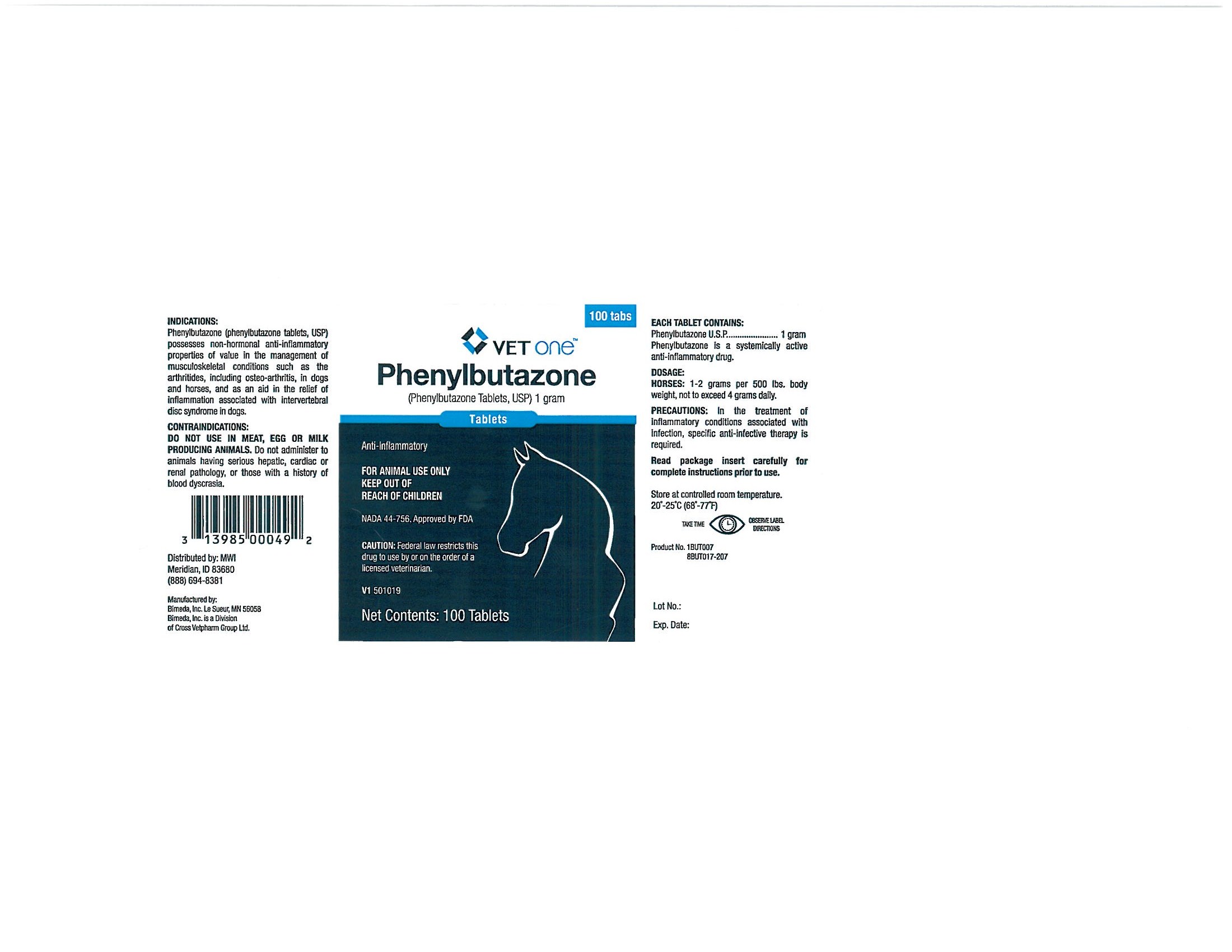PHENYLBUTAZONE- phenylbutazone tablet
Drug Labeling and Warnings
Drug Details [pdf]
- GENERAL PRECAUTIONS
- DESCRIPTION
-
INDICATIONS & USAGE
ACTIONS AND USES:
Kuzell (1,2,3), Payne (4), Flemming (5) and Denko (6), demonstrated clinical effectiveness of phenylbutazone in acute rheumatism, gout, gouty arthritis and various other rheumatoid diseases in man. Anti-inflammatory activity has been well established by Fabre (7), Domenjoz (8), Wilhelmi (9), and Yourish (10).
Lieberman (11) reported on the effective use of phenylbutazone in the treatment of conditions of the musculoskeletal system in dogs, including posterior paralysis associated with intervertebral disc syndrome, fractures, arthritis and injuries to the limbs and joints. Joshua (12) observed objective improvement without toxicity following long-term therapy of two aged arthritic dogs. Ogilvie and Sutter (13) reported rapid response to phenylbutazone therapy in a review of 19 clinical cases including posterior paralysis, posterior weakness, arthritis, rheumatism and other conditions associated with lameness and musculoskeletal weakness.
Camberos (14) reported favorable results with phenylbutazone following intermittent treatment of thoroughbred horses and arthritis and chronic arthrosis (e.g. osteoarthritis of medical and distal bones of the hock, arthritis of the stifle and hip, arthrosis of the spine and generalized arthritis). Results were less favorable in cases of traumatism, muscle rupture, strains and inflammatory conditions of the third phalanx. Sutter (15) reported favorable responses in chronic equine arthritis, fair results in a severely bruised mare, and poor results in two cases where the condition was limited to the third phalanx.
INDICATIONS:
Phenylbutazone possesses non-hormonal, anti-inflammatory activity of value in the management of musculoskeletal conditions in dogs and horses such as the arthritides, including osteoarthritis, and as an aid in the relief of inflammation associated with intervertebral disc syndrome in dogs.
- CONTRAINDICATIONS
- WARNINGS
-
WARNINGS AND PRECAUTIONS
HAZARDS AND PRECAUTIONS:
1. Use with caution in animals with a history of drug allergy.
2. Stop medication at the first sign of gastrointestinal upset, jaundice or blood dyscrasia. Authenticated cases of agranulocytosis associated with phenylbutazone have occured in man. Phenylbutazone induced blood dyscrasias have been reported in dogs. Throbocytopenia and leukopenia are early manifestations followed by nonregenerative anemia. The occurrence of this reaction is not dose depended and is unpredictable. To guard against this possibility, conduct routine blood counts at not more than 7 day intervals during the early course of therapy, and at intervals of not more than 14 days throughout the course of therapy. Any significant fall in the total white count, relative decrease in granulocytes or black or tarry stools should be regarded as a signal for immediate cessation of therapy and institution of appropriate treatment.
3. When treating inflammatory conditions associated with infection, specific anti-infective therapy is required.
4. Response to phenylbutazone therapy is prompt, usually occurring within 24 hours. If no significant clinical response is evident after 5 days of therapy, re-evaluate diagnosis and therapeutic regimen.
-
DOSAGE & ADMINISTRATION
DOSAGE-DOGS:
ORALLY
20 mg per pound body weight (100 mg/5 lbs.) daily in 3 divided doses, not to exceed 800 mg daily regardless of body weight.
DOSAGE-HORSES:
ORALLY 1-2 grams per 500 lbs. body weight, not to exceed 4 grams daily.
ADMINISTRATION:
1. Use a relatively high dose for the first 48 hours, then reduce gradually to a maintenance dose. Maintain lowest dose capable of producing the desired clinical response.
2. In many cases tablets may be crushed and given with feed. Reduce the dosage as symptoms regress. In some cases treatment may be given only when symptoms appear with no need for continuous medication.
3. In animals, phenylbutazone is largely metabolized in 8 hours. It is recommended that a third of the daily dose be administered at 8 hour intervals.
4. Many chronic conditions will respond to phenylbutazone therapy but discontinuance of treatment may result in the recurrence of symptoms.
- STORAGE AND HANDLING
- HOW SUPPLIED
-
REFERENCES
REFERENCES:
1. Kuzell, W.C., Schaffarzick, R.W., Naugler, W.G., Mankle, E.A., A.M.A. Arch. Int. Med 92:646,1953.
2. Kuzzel, W.C., Schaffarzick, R.W., Brown, B., Mankle, E.A., Jour. Amer. Med. Assoc. 149:729, 1952.
3. Kuzell, W.C., Schaffarzick, R.W., Cal. Med 77:319, 1952.
4. Payne, R.W., Shetlar, M.R., Farr, C., Hellbaum, A.A., and Ishmael, W.K.T., J. Lab. Clin. Med. 45:331, 1955.
5. Flemming, J. and Will, G., Ann. Rheumat. Dis. 12:95, 1953.
6. Denko, C.W., Ruml, D., Amer. Practit. 6:1865, 1955.
7. Fabre, J. and Bergen, A., Semaine Hop. (Paris) 31:87, 1955.
8. Domenjoz, R., Theobald, W. and Morsdorf, K., Arzneimittel-Forsch. 5:488, 1955.
9. Wilhelmi, G. and Pulver, R., Arzneimittel-Forsch. 5:221, 1955.
10. Yourish, N., Paton, B., Brodie, B.B. and Burns, J.J., A.M.A. Arch. Ophth. 53:264, 1955.
11. Lieberman, L.L., Jour. A.V.M.A. 125:128, 1954.
12. Joshua, J.O., Vet. Rec. 68:60 (Jan. 21), 1956.
13. Ogilvie, F.B. and Sutter, M.B., Vet. Med 52:492-494, 1957.
14. Camberos, H.R., Rev. Med. Vet. (Buenos Aires) 38:9, 1956.
15. Sutter, M.D., Vet. Med. 58:83 (Feb.), 1958.
- GENERAL PRECAUTIONS
- PRINCIPAL DISPLAY PANEL
-
INGREDIENTS AND APPEARANCE
PHENYLBUTAZONE
phenylbutazone tabletProduct Information Product Type PRESCRIPTION ANIMAL DRUG Item Code (Source) NDC: 13985-019 Route of Administration ORAL Active Ingredient/Active Moiety Ingredient Name Basis of Strength Strength Phenylbutazone (UNII: GN5P7K3T8S) (Phenylbutazone - UNII:GN5P7K3T8S) Phenylbutazone 1 g in 3.027 g Product Characteristics Color white Score no score Shape ROUND Size 24mm Flavor Imprint Code NA Contains Packaging # Item Code Package Description Marketing Start Date Marketing End Date 1 NDC: 13985-019-01 1 g in 1 BOTTLE Marketing Information Marketing Category Application Number or Monograph Citation Marketing Start Date Marketing End Date NADA NADA044756 12/17/1976 Labeler - Vet One (019926120) Registrant - Bimeda Inc Division of Cross Vetpharm Group Ltd (043653216) Establishment Name Address ID/FEI Business Operations Bimeda Inc Division of Cross Vetpharm Group Ltd 043653216 manufacture
© 2025 FDA.report
This site is not affiliated with or endorsed by the FDA.
